The Thermal Data
Moving on from the restriction test bench the GTS radiator was loaded into the thermal test chamber for a series of 9 tests – consisting of 3 flow rates, each having 3 different fan rpm rates tested. I felt the thermal test data was most important and which you as the reader would be most interested in.
Below is the final data results gathered from at least 2 data logging runs at each flow rate and fan rpm combination. The most stable 15 minute period from each logging run was used and then averaged with the other runs to obtain the data for the table below. A total of 16 temperature sensors were used in the thermal test chamber (8 air in, 2 air out, 3 water in, 3 water out) each take a reading every second and logged via a CrystalFontz unit. The data in the table below is the result of the logging runs which has then been used to create all the plots and tables there-after.
The performance metric of critical importance is the delta between the warm coolant temperature in and the cold ambient air temperature in to the radiator. Given that the system is well insulated and in equilibrium and we know the heat input to the system then we can also calculate a very important number – that is the amount of power required to raise the coolant temperature 1C (or 10C which is more useful reference point).
Let’s take a look at the Delta T results from the tests.
So the Delta T’s were not greatly affected by varying flow rate. However Delta T is not always helpful when thinking about how many radiators you would need to cool your system. Instead it’s more useful to know the delta/W, or more usefully, the inverse metric of W/delta C.
The metric plotted below tells us how many watts are dissipated by the radiator when the coolant rises 10C above ambient temperatures. (10 Delta T):
As expected increasing fan speed and therefore airflow through the radiator is the primary determinant in changing the radiators performance. Of special note here is the 1.0 GPM Push Only results are equal to and higher the 0.5 GPM Push/Pull at medium and high fan speeds. In fact we could could say there is very little variance between the flow rates at each fan speed.
This data can now be plotted as a pretty curve so that an end user can interpolate their own fan speed. Note again that the extrapolation of the curve is much more sensitive to error than in between the tested range.
This makes it easier to see that at higher fan speeds that a low flow starts to impact the cooling performance. This makes sense if you take it to the extreme and think about a very low flow rate where the coolant is already cooled 99% of the way to ambient with 10% of its journey through the radiator. In this example the radiator is not being efficiently used. 90% of the radiator surface area would then be wasted and you could have used a smaller radiator.
If we now come back to the push data it’s good to compare only the push to push/pull data in an “apples to apples” fashion by only looking at the 1GPM data:
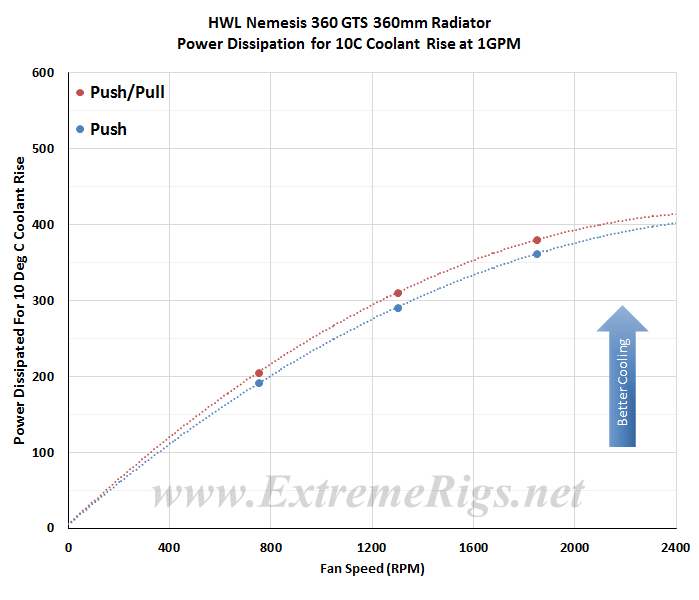 Push Only gives around 94% (averaged) of the performance of the Push/Pull 1.0 gpm test results on this radiator.
Push Only gives around 94% (averaged) of the performance of the Push/Pull 1.0 gpm test results on this radiator.
In this next chart all three Push Only results at 1.0 GPM flow rate were plotted to produce one curve and we compared the results against the other slim rads Push Only results.
While the margins look small the GTS360 is a clear leader with fan sppeds from very low almost up until the high speed where the very high FPI Koolance rad takes over.
Now let’s compare Push vs Push/Pull:
For the Push/Pull comparison chart we have averaged the 3 fan speed test results at each flow rate to produce the curves. Averaging reduces test error of course so this helps further to be sure of our data and is more useful therefore for comparing to other radiators.
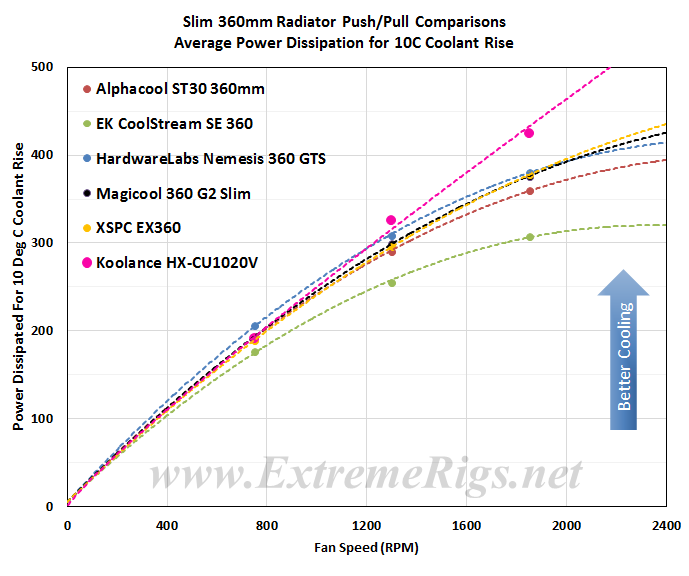 At low to medium fan speeds the 360GTS is again the leader of the tightly grouped pack. As with most slimmer radiators the difference is small.
At low to medium fan speeds the 360GTS is again the leader of the tightly grouped pack. As with most slimmer radiators the difference is small.
Now let’s analyze that data some more….








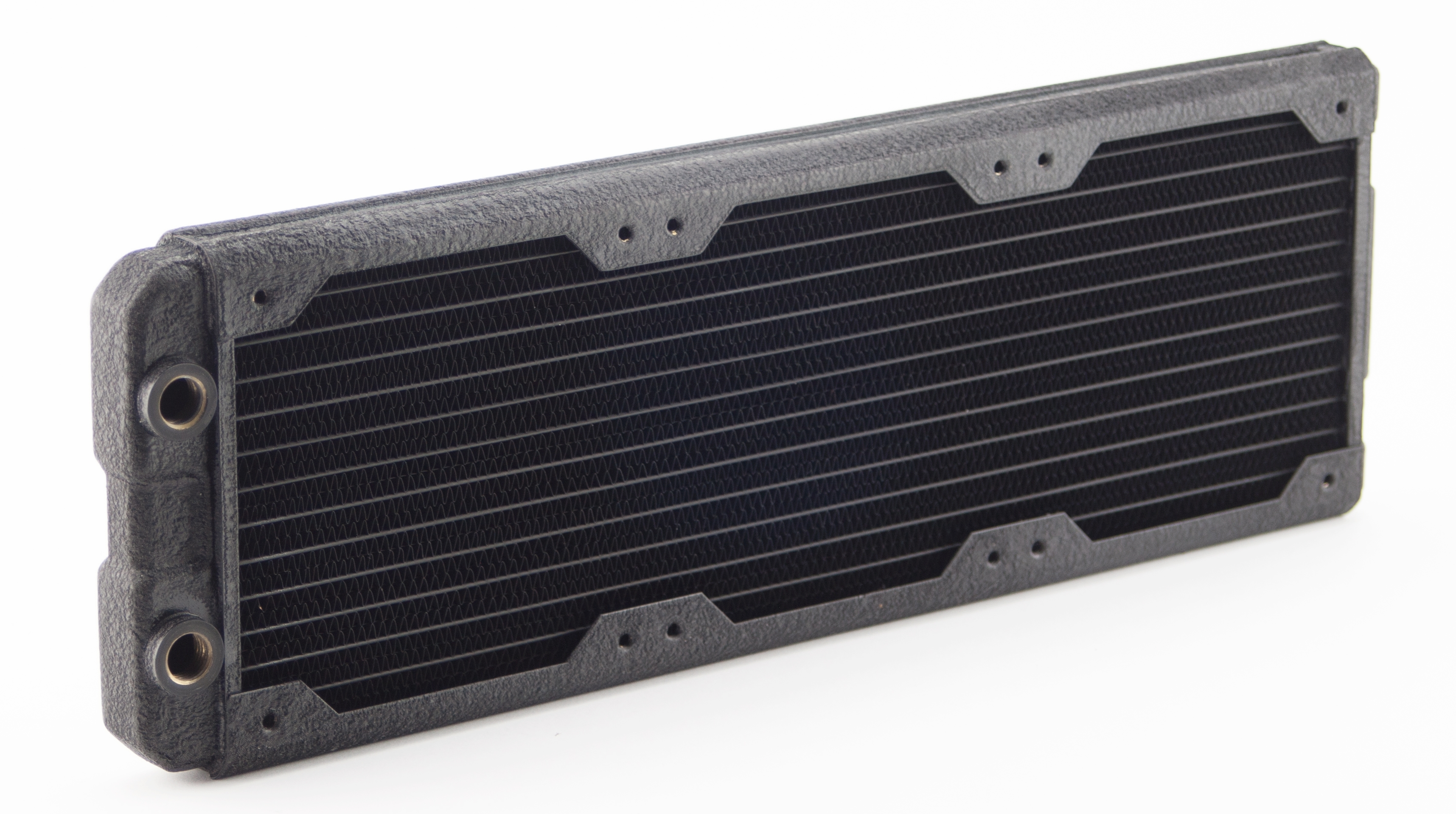
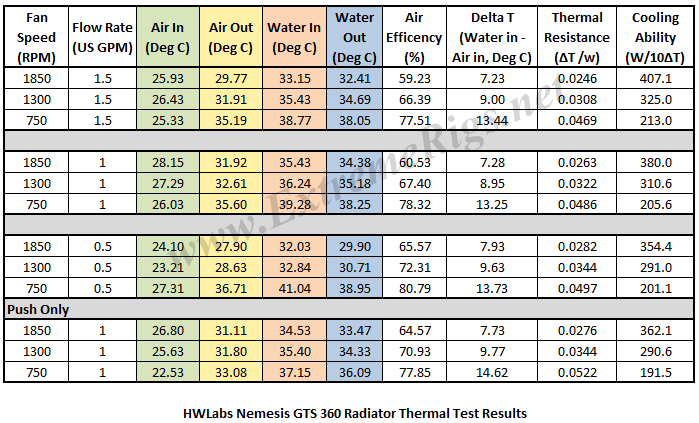
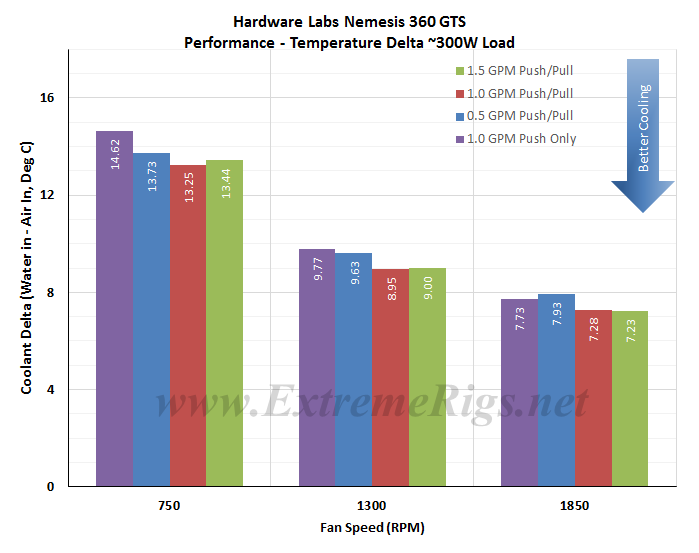
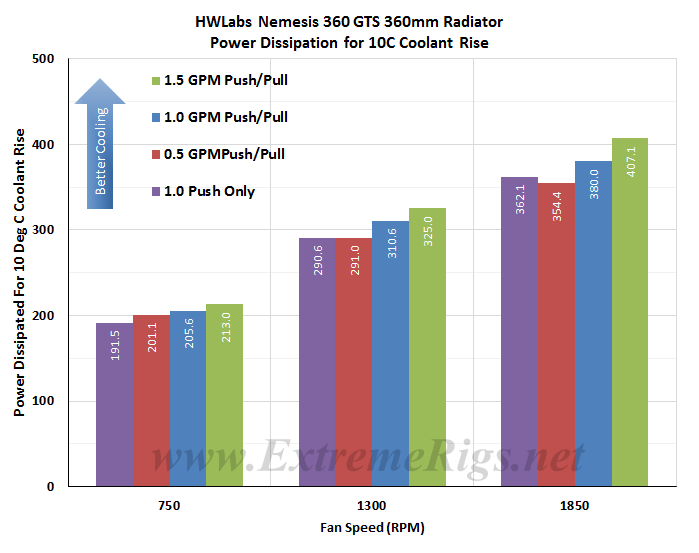
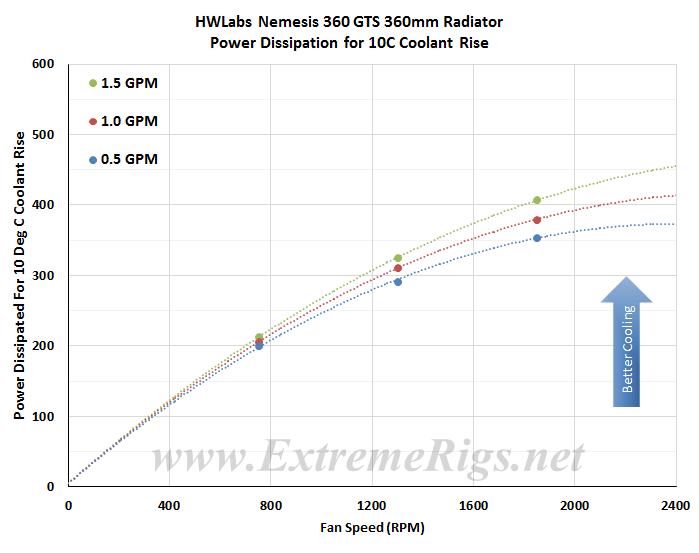
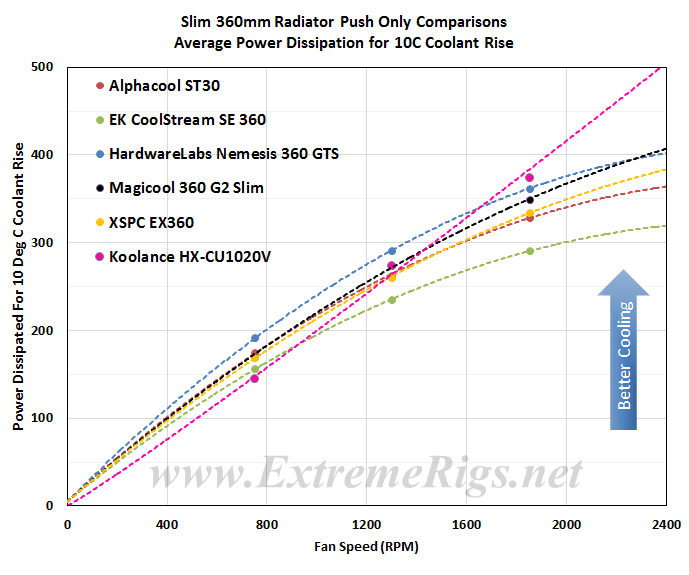




[…] Radiator Coolgate G2 360 Radiator EK PE 360 Radiator Hardware Labs Alpha Extreme III 360 Radiator Hardware Labs Nemesis GTS 360 Radiator Hardware Labs Nemesis GTX 360 Radiator Hardware Labs SR-1 360 Radiator Koolance HX-360XC 360 […]
I wish they did multi port versions of the Nemesis GTS. That would be the logical next design evolution for HWLabs.
What are the implications for using a highly restrictive rad like the 360gts? Does it play nice with other rads in a multi rad cpu/gpu cooled rig?
thanks
Hi David,
This is a great question, that is rather complicated to answer, as so much of the detail is reliant on the other components in you water cooling loop.
I’ll try to make the answer as simple as possible to understand, even if some the terminology isn’t technically correct.
So…
Let’s start back with the pump/s & pump top set up (which I’ll just call pump) that one may be using as it is the heart of any water cooling system.
The pump has a maximum amount of “power” with which it is able to move the coolant.
The maximum “power” has 2 dynamically linked properties which we call “Flow Rate” and “Pressure”
As one of these properties goes up, then the other must come down, because the pump has a limit on it’s (maximum) “power”
So let’s imagine that the pump is set up in a loop all of it’s own, with no other components.
The flow rate will be very high because the restriction level is low and the none of the pump’s “power/pressure” is needed to overcome any restrictions.
Now – if we start adding in components such as blocks and radiators we are placing restrictions the pump must overcome.
To do this the pump’s “power” is dynamically changed depending on the restriction level of the components.
More restriction = is more pressure needed by the the pump to get the coolant through the block/radiator….
which results in a lower flow rate.
So with a restrictive radiator like the 360GTS it will play nicely with other components in the loop.
The question is, does your pump have enough “power” to achieve a flow rate you desire after using up “pressure” on the components.
If nothing else, that should get you thinking
wow, perfect explaination.
Wonder if anyone knows how much the 360 GTS Nemesis weighs in grams? I almost replaced it with the Coolgate 360HD as the specs seemed better but when I held both in my hands it seemed liked the Nemesis GTS 360 was heavier as in better materials and more copper and had just as much radiator height internally though the 360hd had a taller casing and weighed 790g. Could not find wieght info published online anywhere. Mine is the X-Flow version however. Thanks
[…] reviewed the regular Nemesis 360 GTS for the Extreme Rigs Rad Round Up 2015, and we have also featured it’s data in some reviews which […]
[…] offering from HWLabs and is the thinnest of the 140 rads that we’ll be looking at. The Nemesis 360 GTS really surprised us in the 360 roundup as it was competitive with larger radiators despite […]
[…] we reviewed the Nemesis 360 GTS last year, we may make a comparison or two between the 280 and 360 variants. The 280mm version only […]
Thanks for the excellent review. I really can’t figure out if this rad is for me though?? I will be using x2 360 rads to cool a 5820K+1080 GPU, using lower RPM fan speeds, but the flow restriction issue has me concerned. The Alphacool Nexxxos ST30 360 seems VERY close in performance, but with better flow restriction. Really don’t know which one to go for?! I have an EK-XRES 140 Revo D5 PWM pump/res.
I’m in the same situation as you…..
I also have the Ek X-Res 140 Revo D5 and also like to know what’s the better 360m slim rad at the moment?
Will the Nemesis GTS 360 work ok with this pump? I will only have the an EK block for the cpu in my loop.
Thanks.
A D5 puts out about 4.5 PSI at 1GPM, let’s assume 1 PSI for your cpu block and 0.5 PSI for your gpu block. 1 Nemesis GTS rad is ~1 PSI at 1GPM. So that’s a total of 3.5PSI at 1GPM which is well within reach of a D5 So yes the GTS will be fine. It’s more of a problem if you’re going to be using 3-4 as well as multiple gpu blocks and a weaker pump
So yes the GTS will be fine. It’s more of a problem if you’re going to be using 3-4 as well as multiple gpu blocks and a weaker pump 
What about pump like Magicool DCP450?
Im planing to use Alphacool Eisblock XFX – its very restrictive
2x Nemesis GTS 240mm – again… very restrictive
and single GPU full cover block.
Comments are closed.